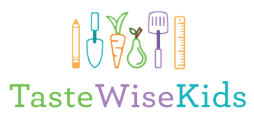A Conversation: Teaching Kids about Food
A huge part of what we do at TasteWise Kids is food education – we want kids to know what healthy food is (we love veggies!), where it comes from (plants or animals grown on farms), and how to make it delicious (balance it to your taste). Food doesn’t grow on shelves so it’s important to connect kids with the origins of what they love to eat and then help them learn how to make good food choices. With extra daylight on our hands and Spring approaching, use any of these resources and tips to keep families and kids engaged and thinking about their food.

- Be a grower. An edible garden is a fun way for kids to see first-hand that food comes from plants and how it grows. Herbs are an easy choice to maintain, they are fun to smell and touch, and are a great way to get children involved in meal making. Another option is scallions, save the bottoms and plant them for an endless supply (they’ll even grow in a glass jar with just water and sunlight!). Kids may be more willing to try foods when they’ve put in effort and care into growing it themselves. See creative ways for kids to grow using household items with this
list of ideas .
- Explore. Your local library or bookstore is a great resource for families to learn about food together. Books and their fun characters can spark interest in new foods, broaden their viewpoints, and encourage healthy eating habits. A fun read that kids can find relatable but has a quirky twist is Little Pea by Amy Krouse Rosenthal. Another favorite is How to Feed Your Parents by Ryan Miller.
- Plan an adventure. A trip to your local farmer’s market can be an exciting experience for families, it is an opportunity to get to know the people who grow your food. Farmers are usually open to talk about their growing practice and are a great resource for recipe ideas. Get your kids in on the action and encourage them to ask questions. Visit any one of Maryland’s farmer’s markets .
- Talk about it. When you hand your kid produce, chances are the first thing they do is peel off the sticker, but these important labels tell us what region or country our food comes from. A thought provoking mealtime conversation is where what is on your plate is grown and how it makes its way to the dinner table. One activity you can try at home is food mapping: have our kids draw and color small pictures of foods they eat and place it on a map. This can inspire talks about where we get our food, how it is transported, and how season affect what we eat and when. Learn more about ways you can educate kids on the farm to table process with this insightful article from the Washington Post.
